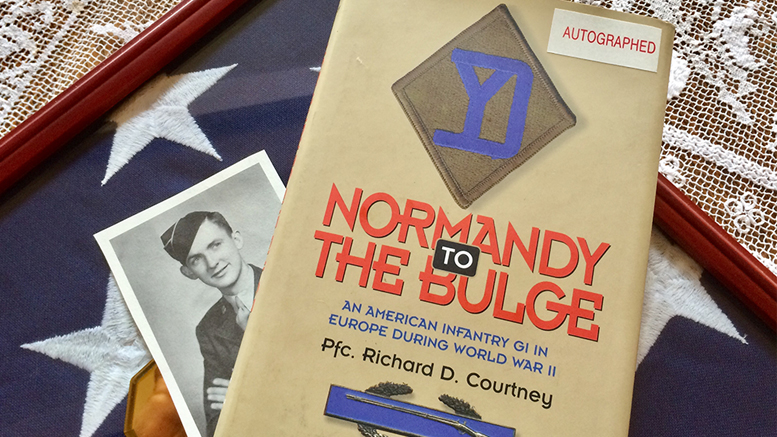By John Carlson—
Dick Courtney was a man of great stature, not just physically, but also as measured by friendliness, kindness and humor.
That’s a rare combination.
I got to know Courtney years ago, following the publication of his book “Normandy to the Bulge: An American Infantry GI in Europe During World War II.”
Being a guy who sometimes hangs with writers, I had met a couple Greatest Generation war veterans from hereabouts who had also written war memoirs. There was John F. Ireland, whose fine book was titled “My Story.” There was also my friend and former newspaper co-worker Dick Stodghill, a writer’s writer with a slew of columns and published mystery short-stories, both in the pulps and hard-cover books, to his credit. He penned “Normandy 1944: A Young Rifleman’s War.”
But while Courtney had some literary leanings, he was in his seventies before he went through the trying process of getting his memoir published, it being brought out by Southern Illinois University Press in 1997. At best, he had been a long shot for success, publishers not necessarily rushing to publish books by old soldiers.
Danged if he didn’t do it, though.
In meeting Courtney, a Pennsylvania native who eventually founded Muncie’s General Vending Service, I enjoyed a number of get-togethers with him and his lovely wife, Connie. Key to those meetings, besides the laughs, were his stories about spending more than two hundred days as a 19-year-old kid carrying a Colt .45 and a bazooka, risking his life to knock out Nazi tanks.
Which brings up more of Courtney’s attributes: guts, bravery, cojones … you name it.
Being trucked through Cherbourg, Courtney recalled seeing the ravages of war, as glimpsed in the pages of Life magazine. “… only this time it was real. We all pointed out the third-floor bathtub sticking out in the air all by itself, supported by the drain pipes since the two floors under it were all rubble in the cellar.”
Soon enough would come the days, weeks and months spent in uniforms stiff with dirt, sweat, dust and crap, the GI’s heartfelt wish for a hot shower as unrealistic as wishing for a million bucks.
Of another sight, he recalled, “All around us … were wrecked German tanks, mortars, dead horses, and cattle and a weird atmosphere of rising fog that made it seem like the landscape of the moon.” Speaking of cattle, Courtney recalled the GIs had cut steaks from the dead cows’ bodies. Nobody knew when the animals had been killed, he said, but “The steak looked better than C-rations, so we ate them.”
There were also, of course, horrific numbers of dead soldiers. At one early point his unit found a squad of six Germans, their faces blackened and sprawled on their backs, dead. “The war seemed real now as we looked into their faces,” Courtney wrote. “They were all about eighteen years old …”
Bad as that was, the deaths of fellow GIs hit much harder.
He recalled crawling out of a foxhole he had dug when an American tank rolled up and promptly exploded. “We’d slept in a minefield and didn’t even know it!”
Some of his tragic tales were macabrely ironic. Courtney wrote about taking cover in a farm house outside of which an American Sherman tank was hit. Climbing atop it, GIs hurriedly pulled the tank’s sole survivor out the turret, carried him into the kitchen and cut off a foot and ankle that were dangling by a single string of flesh. Then the wounded soldier asked Courtney if he’d go back out to retrieve a bag he’d tied to his tank’s turret.
“I said, ‘Man, you don’t know what you are asking.’”
“He said, ‘Please, Mac, it’s important to me.’”
So ignoring his own buddies’ advice, Courtney dashed to the tank, snatching the bag shortly before the armored vehicle exploded. Handing the bag to the wounded tank crewman, Courtney told the guy he’d nearly been killed, and said he hoped what was inside that bag was important.
“Yeah it was,” answered the kid who’d just lost his foot. “I had my last pair of dry socks in there.”
There was a time in the town of Eschdorf when Courtney entered a wooden shed, just to see what was inside, and found dozens of frozen GIs, stacked like firewood.
“I quietly closed the shed door,” he said.
Besides fierce combat, along the way there was no shortage of looting. The GIs considered it payback, giving the Germans a taste of what they’d imposed on the ravaged European continent. Meanwhile, more and more often they were coming into contact with German civilians.
Courtney wrote how in Shleusingen, he and his comrades freed an enclosure of French slave laborers, then took them to the gasthaus for beers. The tavern’s portly bartender began sulking when they made him serve the French, and when the keg ran dry he claimed he had no more. “Larry Choiniere and I drew our .45s and yelled, ‘Bringen mehr bier!’ (bring more beer) …”
The result?
“ … fatso got the message.”
Still, the war’s brutality was unabated. With its end nearing, Courtney was part of a troop movement catching up to German soldiers herding thousands of prisoners eastward. When they reached them, those countless prisoners in blue and white striped concentration camp uniforms lay machine-gunned on the ground.
“It was a sickening sight,” Courtney wrote.
As the fighting progressed, the jaded GIs pondered how their war slogans had changed since they’d been drafted or enlisted. What had been “Victory in ’43!” morphed into “Win the war in ’44!” Now, the best they could do was “Stay alive in ’45!” But the day came when they rolled up on the bank of the Danube River.
“At last,” Courtney recalled, “we had run out of German land to conquer.”
A lifelong Catholic, he found the war had profoundly affected him religiously, strengthening his faith. He recalled how the words of a missal read at a battlefield mass struck a deep chord.“It hit me then! This is for real! ‘This is My Body! This is My Blood!’”
Later, with the Allied victory, Courtney and his comrades found themselves in Czechoslovakia, being serenaded by displaced Polish women bearing flowers and singing the Polish national anthem for them. The GIs clapped and cheered, then the Polish women motioned for the men to sing America’s national anthem for them.
“We all looked at each other,” Courtney recalled. “Does anyone know the words to the ‘Star Spangled Banner?’”
None of these GIs, the ultimate American patriots, did.
“‘OK. Let’s sing ‘God Bless America,’” Courtney said. “They won’t know the difference. So we did, very enthusiastically. The women had tears of joy in their eyes, and soon all of us did, too.”
Which brings us to the reminder that Monday is Memorial Day, a fine time for fun and picnics, but also the most fitting day to remember all Americans who have served, particularly those who died while fighting for our freedom.
As for my buddy Dick Courtney, he died at the age of 83 in 2009, joining that silent line of heroes from Boston and Lexington to Iraq and Afghanistan, marching off into American history.
John’s weekly columns are sponsored by Beasley & Gilkison, Muncie’s trusted attorneys for over 120 years.
About Beasley & Gilkison
We listen, analyze your unique situation, and prepare a course of action that best fits your needs. Contact one of our attorneys to schedule a consultation, or for more information, call 765-289-0661 or visit our Facebook page or website at beasleylaw.com.

A former longtime feature writer and columnist for The Star Press in Muncie, Indiana, John Carlson is a storyteller with an unflagging appreciation for the wonderful people of East Central Indiana and the tales of their lives, be they funny, poignant, inspirational or all three. John’s columns appear on MuncieJournal.com every Friday.



